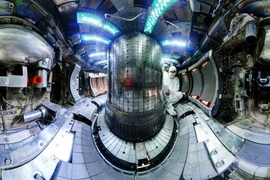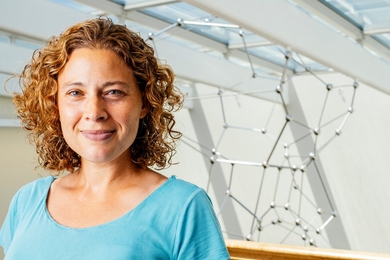Graduate student Leigh Ann Kesler is pursuing her two great interests: fusion science and rock climbing. One day she finds herself scrambling up bare rock faces to view grand vistas of mountains and valleys carved by glaciers, the next she is in the laboratory, exploring minute changes in the depth of materials being eroded by fusion forces.
Kesler studies at MIT’s Plasma Science and Fusion Center (PSFC), and dates her interest in fusion back to an 11th-grade persuasive writing assignment. Inspired in part by her father’s interest in the potential of nuclear energy, she decided to investigate fusion. Searching for the topic at the library in her Fisher, Illinois, high school, she found just one 1970s-vintage book on the topic, but its description of a magnetic fusion device called a tokamak was compelling enough to hook her for good.
As an undergrad at the University of Illinois, Kesler studied nuclear, plasma, and radiological engineering, learning the basics about how plasmas affect materials from one of her mentors, Professor David Ruzic. Working in his laboratory on projects related to semiconductor manufacturing as well as fusion, she gained a reputation for expertise with plasma diagnostics. Graduate students several years her senior soon began to seek her help with their projects.
“I don’t know if I was an expert,” she says, laughing. “But I had several advantages. I had small hands. I could reach inside of the bottom of the chamber [of the experiment]. I’d been there long enough that they knew I wasn’t going to break things.”
Understanding fusion devices
Now at MIT, she is continuing her research in materials science and fusion research under the guidance of Professor Dennis Whyte, head of the Nuclear Science and Engineering Department and director of the PSFC, and Assistant Professor Zach Hartwig. As she did in Illinois, she works in a lab that utilizes small-scale plasma devices for ex situ observation of plasma surface interactions.
Her main focus is erosion of materials inside fusion devices, where strong magnetic fields keep the hot plasma fuel confined and away from the walls of the vacuum chamber where fusion reactions occur. But the plasma can still affect the walls, resulting in surface erosion and other changes.
“It’s very difficult to determine exactly how a particular kind of plasma discharge affects the interior material of the machine,” Kesler says. "We can’t be sure of the amount of erosion occurring at any particular moment. Erosion affects not only the wall materials, but also the plasma itself, which can become contaminated by the eroded materials. If you are eroding or even melting the surfaces you will eventually destroy the divertor, which is designed to remove impurities from the plasma.”
She works mainly on a 2 megavolt electrostatic accelerator called DANTE in the Vault Laboratory for Nuclear Science, which is part of the Center for Science and Technology with Accelerators and Radiation (CSTAR). The lab is a shielded, underground facility that allows her to work safely with a deuterium ion beam. She also uses CSTAR's Cambridge Laboratory for Accelerator Surface Science, giving her the versatility of working with two ion sources.
Kesler is searching for a way to measure, on a shot-by-shot basis, what changes are happening on the interior surface of the tokamak in order to gain a better understanding of how different plasma conditions affect surfaces. To this end, she will use the accelerator to create “depth markers” to help measure changes in the metallic surfaces. She is working with tungsten, a metal that will likely be used for the divertors of future tokamaks.
“Accelerators can be used to implant stuff into the surface of a material," she says. A layer of a material, like boron, put close to the surface can be used as a reference point.
"If the location of this layer changes after interacting with the plasma that means the amount of tungsten on the surface has changed," she says. "Either something has been added or something has been taken away.”
Kesler is still fine-tuning what that reference point will be, the best material to use, how to create the depth marker, and how to use the accelerators to see how the plasma has affected the surface. Her technique should be applicable to any material and will be relevant to tokamaks around the world, allowing researchers to diagnose the effect of each plasma shot as it happens.
“Addicted to hiking”
While the lab keeps her busy, Kesler has been able to indulge her love of hiking and rock climbing, not only in the mountains of New England, but in places as far away as Machu Picchu, the Faroe Islands, and Mount Vesuvius. She started rock climbing during a summer internship in Los Alamos, New Mexico, where after work she would explore the area crags with friends.
“It turned into the best summer of my life, and I was addicted to hiking and climbing after that.”
At MIT she got involved with more aspects of the sport when she started going on trips with the MIT Outing Club (MITOC). Soon she was a hiking and climbing leader, and is currently on the board of directors.
“MITOC has been an amazing part of my grad school experience, allowing me to make friends with shared interests and to let me escape the confines of the city on the weekends. As a country girl, I get sick of the city, so New Hampshire has been my second home while I'm here.”
On a mountain she can study the surface of a rock that will provide her next foothold instead of the interior surface of a tokamak. She can breathe the thin air of high altitudes before returning to her underground laboratory. She was excited about her recent hike with five friends from MITOC to Gannett Peak, Wyoming’s highest point, where she was able to watch the total eclipse on Aug. 21.
“We hiked for two days to high camp, took one day to summit, then one day to retreat. I had bruised my heel six weeks earlier in a climbing accident, so I was out of shape, but the trip was still amazing. Viewing the totality of the eclipse was mind-blowing. The 360-degree sunset/sunrise and the reality of the sun disappearing from view was something I cannot describe. It is an experience of a lifetime.”
Now at the beginning of her sixth year, Kesler is still researching and writing, but starting to consider her options after graduation. “An international postdoctoral position in materials development would be great. But I’m not so much interested in where I go as in doing interesting work,” she says.
Ideally that work will be situated not far from a mountain, she says. “There are always more rocks to climb.”










